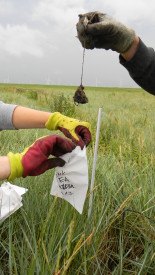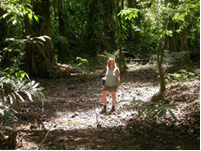Seasonal changes in Salicornia depressa metal accumulation and rhizosphere composition
Seasonal changes in Salicornia depressa metal accumulation and rhizosphere composition
Duration: June 2023—September 2023
Funding Source: Startup grant from the University of Massachusetts Boston to B. Moyers
Principal Investigators, institutional affiliation: Brook Moyers / Alice Palmer
Affiliation: University of Massachusetts Boston, Biology
Email: brook.moyers@umb.edu, alice.palmer001@umb.edu
Project Description: Salicornia species, known in New England as pickleweeds, form mutually beneficial relationships with soil microbes living on the plant’s roots (the rhizosphere), which can help improve plant growth under stressful conditions. They are also capable of accumulating metals from the soil at high concentrations. We are studying how the bacteria present in the Salicornia depressa rhizosphere differ from those in the soil surrounding the plant. We also are interested in how changes in the plants’ biology over the course of the growing season and seasonal changes in salt marsh soil chemistry affect both the rhizosphere’s composition and its ability to accumulate metal from soil. To investigate this, we are collecting samples of S. depressa, its rhizosphere, and the surrounding soil in June, before the plants begin to flower, in August, as they are flowering, and in September, as they begin to senesce. We will sequence bacteria in the rhizosphere and surrounding soil for each timepoint. We will also test the amount of metal in the soil, in S. depressa’s roots, and in S. depressa’s shoots at each timepoint to determine how much metal the plant is accumulating and where it is being stored. These results will help us understand how S. depressa copes with metal stress and its potential in removing metals from polluted marshes.
Groundwater controls on microbial communities in coastal aquifers
Project Title: Groundwater controls on microbial communities in coastal aquifers
Date: 6/2019-6/2020
Principal Investigator(s): Dr. James Heiss
Affiliations: UMass Lowell
Summary: Groundwater discharge from the seabed into coastal ecosystems carries nutrients and other chemicals that affect surface water quality and ecosystem health. Microbial processing of groundwater contaminants prior to discharge alters the chemistry of discharging groundwater and can be an important ecosystem service that reduces nutrient fluxes that would otherwise contribute to coastal eutrophication. The objective of this research is to understand how microbial communities process nutrients and other chemicals in coastal aquifers. The work will aid managers aiming to reduce nutrient loads to surface water bodies. Groundwater wells, water quality sensors, and porewater sampling will provide information into how groundwater hydrology affects microorganisms in the subsurface and nutrient fluxes in discharging groundwater.
Photochemical degradation of dissolved organic carbon at Waquoit Bay
Project Title: Photochemical degradation of dissolved organic carbon at Waquoit Bay
Date: 7/2018-7/2019
Principal Investigator(s): Collin Ward, Sam McNichol
Affiliations: WHOI
Summary: Dissolved organic carbon is a central intermediate in the global carbon cycle. For nearly fifty years we’ve known that sunlight can alter the chemical make-up of dissolved organic carbon, which changes how fast microbes respire it to carbon dioxide. However, very little is known about the rate that this coupled photochemical biological reaction occurs. In this study, we are using Waquoit Bay as a field site to test a new method to quantify photochemical biological dissolved organic carbon degradation. The facility is ideal because (i) it offers easy access to diverse water types (i.e., lake, river, groundwater, estuarine), and (ii) water quality data is continuously monitored.
Decoupled distance–decay patterns between dsrA and 16S rRNA genes among salt marsh sulfate‐reducing bacteria
Project Title: Decoupled distance–decay patterns between dsrA and 16S rRNA genes among salt marsh sulfate‐reducing bacteria
Date: 2016
Principal Investigator(s): Angermeyer, A., Crosby, S.C., & Huber, J.A.
Summary: In many habitats, microorganisms exhibit significant distance–decay patterns as determined by analysis of the 16S rRNA gene and various other genetic elements. However, there have been few studies that examine how the similarities of both taxonomic and functional genes co‐vary over geographic distance within a group of ecologically related microbes. Read full text…Environmental Microbiology, 18(1), 75-86. http://onlinelibrary.wiley.com/doi/10.1111/1462-2920.12821/full
Distinguishing denitrifying organisms across gradients
2016
Robinson W. Fulweiler(Boston University); Teri O’Meara (University of Auckland)
Funding Source(s): Boston University, University of Auckland
Tea bag decomposition experiment
Principal Investigators: Dr. Faming Wang, Dr. Jianwu (Jim) Tang, Marine Biological Laboratory
 We use commercially available tea bags as standardized test kits to gather data on salt marsh decomposition rates. This is a cost-effective, well-standardised method. By using two tea types with contrasting decomposability, we can construct a decomposition curve using a single measurement in time. We will compare the decomposition rate within the high marsh and low marsh, and also in the warmed chamber versus ambient reference. Our data was also included in a worldwide cooperation network to investigate the decomposition rate in different ecosystems using the tea bag method.
We use commercially available tea bags as standardized test kits to gather data on salt marsh decomposition rates. This is a cost-effective, well-standardised method. By using two tea types with contrasting decomposability, we can construct a decomposition curve using a single measurement in time. We will compare the decomposition rate within the high marsh and low marsh, and also in the warmed chamber versus ambient reference. Our data was also included in a worldwide cooperation network to investigate the decomposition rate in different ecosystems using the tea bag method.
To read more about the tea bag experiment and its relationship to blue carbon research, please visit:
http://bluecarbonlab.org/ and also http://www.teatime4science.org/about/the-project/
Microbial Community Composition of Permeable Reactive Barriers – Who Is Really Doing the Work?
 PIs: Jennifer Bowen, UMASS-Boston
PIs: Jennifer Bowen, UMASS-Boston
Ken Foreman, MBL Ecosystems Center
Funding: MIT Seagrant
Description: Permeable Reactive Barriers (PRBs) are currently being tested at the Waquoit Bay Reserve as a potential partial mitigation strategy for nutrient pollution. The barriers are designed to remove nitrogen by promoting microbially-mediated denitrification but there has been no examination of the microbial community that is responsible for the removal of the nitrogen and no attempt to understand how those microbial communities might respond to future environmental change. This project will use molecular biology to examine how the barriers, and the periodic inundation of seawater, alter the structure and function of the microbial community. This information will help determine the best placement of the barriers to maximize their effectiveness. Understanding how the microbial communities in the two barriers differ and under what environmental conditions the denitrifying bacteria thrive will help to guide future barrier construction, particular in the context of rising sea levels.


